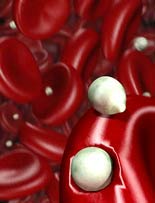KP-15: New synthetic substance to kill malaria parasites
Canadian scientists have announced that they have synthesized a substance that kills malaria parasites, including drug resistant strains. This finding is of great significance in fighting malaria that is raging in 105 countries around the world.

Scientists have created a compound that can kill malaria parasites.In the picture: malaria parasites are invading red blood cells(Photo: WEHI)
Using multidisciplinary techniques, Canadian scientists have succeeded in synthesizing a substance capable of killing malaria parasites, opening up new prospects in treating this dangerous disease.
In a study published in the Journal of Medicinal Chemistry on February 12, experts said, they have created a compound that is able to find and kill malaria parasites. , including parasites of resistant strains.
Known as KP-15 , this artificial compound has been successfully tested in the laboratory with numerous strains of human-endemic parasites, including Plasmodium falciparum - a multidrug-resistant parasite. the most dangerous form of malaria.
According to the study results, after penetrating into ODCase (Orotidine monophosphate decarboxylase) - an enzyme that is very important for the survival and regeneration of parasites - KP-15 will inhibit the activity of this enzyme, thereby signing The worm will be destroyed.
Compound KP-15 was created by applying multidisciplinary techniques such as X-ray crystallography (X-ray Crystallography), computer modeling and medical chemistry. Using X-ray crystallography techniques (a technique in crystallography, in which samples are created by diffraction of X-rays), experts will record and analyze samples taken to determine The 3-dimensional structure of KP-15 is active in the parasite's enzyme.
Then, based on the characteristics of these three-dimensional structures, experts will use computer prototyping tools to establish anti-malarial formulations.

Dr. Kotra: ' This work paved the way for the creation of a new drug against malaria '. (Photo: UHN Research)
The leader of the research team is Dr. Lakshmi Kotra, a molecular and cell specialist of the Toronto Research Institute, and the Director of the Center for Molecular Design and Structure at Toronto General Hospital and pharmacology instructor. - chemistry of the University of Toronto. Kotra's colleagues include Professor Dr. Emil Pai of the Ontario Cancer Institute; Dr. Kevin Kain, Director of McLaughlin-Rotman Global Health Center; and some other scientists.
Dr Kotra said: 'This work paves the way for the creation of a new drug against malaria. We have extensive expertise and sophisticated technology to create compounds that can detect parasitic enzymes'.
He stressed: 'It is important to create this compound because this is the first time malaria parasites are attacked and destroyed by an artificial compound'.
However, according to him, the team needs to prepare for 3-5 years before conducting clinical trials on humans.
According to Dr. Kain, 'this work is an exciting breakthrough, opening the first step in the production of new anti-malarial drugs. It is also a good example of collaboration among scientists in many different disciplines in finding an innovative solution to dealing with the most dangerous diseases. "

Every year, 1 million people worldwide die from malaria.(Photo: WHO)
Professor Richard Weisel, director of the Toronto Institute of General Research, said: ' This study represents a surprising new direction in finding therapies . Evaluation of protein structure and abnormal genes for drug formulation is a new method that we will continue to study to treat serious diseases'.
Malaria is now recorded in 105 countries. Every year, around 500 million people worldwide suffer from this disease and more than 1 million people die.
In Canada, where this study was conducted, the number of malaria patients annually ranged from 364 to 1,029 during the period 1990 - 2002, making the country have a 3 to 10 times higher rate of malaria per capita. compared to the United States. It is also one of the countries with the highest infection rates among developed countries.
According to the research team, global malaria status has increased over the past two decades and will continue to increase for reasons such as global tourism boom; immigrant population is increasing in many countries; drug resistant parasites are developing; and adverse changes in the environment, climate and ecology.
Quang Thinh
- New way to kill malaria parasites
- Discover how to kill malaria-causing parasites
- Discover how to kill malaria parasites
- Kill mosquitoes carrying malaria parasites with foot odor
- Warning about the emergence of drug-resistant malaria parasites
- How to diagnose, treat and prevent malaria
- The United States develops 100% immunization against malaria
- New discovery about malaria
- Decoding DNA of malaria parasite
- New method to effectively kill malaria mosquito larvae
- Viagra helps fight malaria
- Vietnam has appeared chemical resistant mosquitoes, which are at risk of spreading
 Green tea cleans teeth better than mouthwash?
Green tea cleans teeth better than mouthwash? Death kiss: This is why you should not let anyone kiss your baby's lips
Death kiss: This is why you should not let anyone kiss your baby's lips What is salmonellosis?
What is salmonellosis? Caution should be exercised when using aloe vera through eating and drinking
Caution should be exercised when using aloe vera through eating and drinking